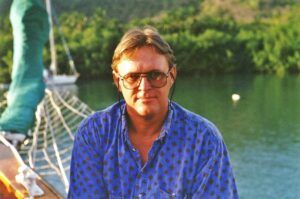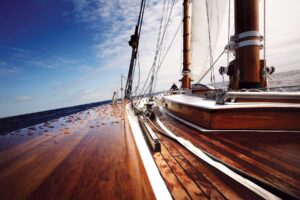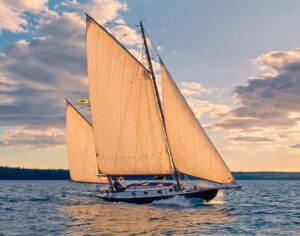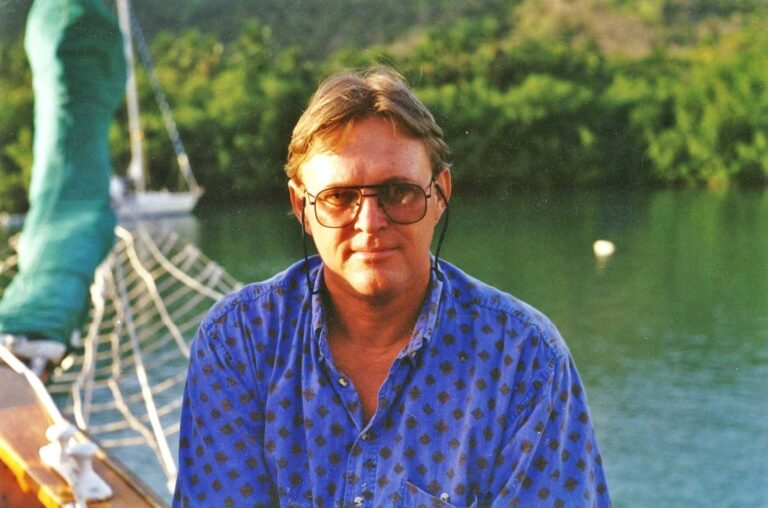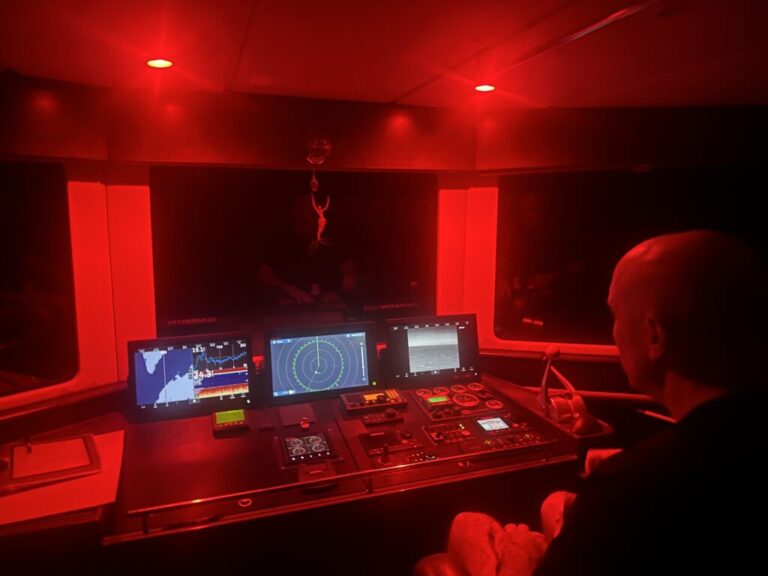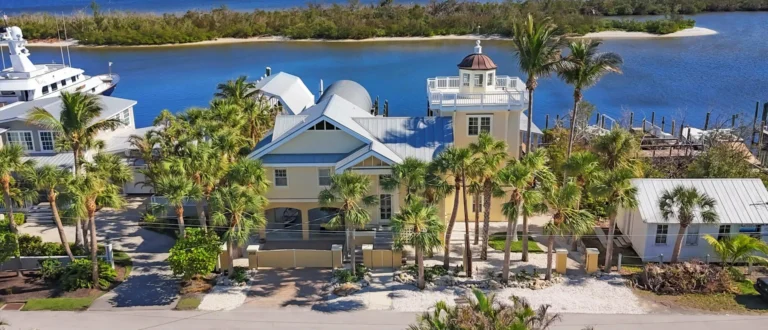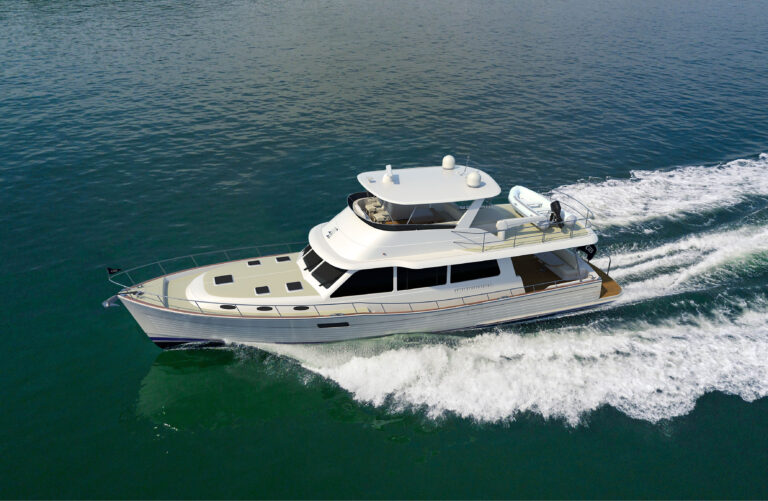Walter Cronkite, at 91, remains an elite sailor
At age 91, Walter Cronkite is among the nation’s sailing elite
The lights are dimmed in the elegant Manhattan vault that is the New York Yacht Club model room as scores of members in blue blazers watch an America’s Cup documentary playing on a large, temporary screen.
For many, it is a home movie. The faces on the screen are all like family: Dennis Conner, Ted Turner, Gary Jobson, Halsey Herreshoff, and club rear commodore David Elwell Jr. among them. For those with deep yachting roots, there are many more familiar faces within this extended family.
Stitching together these scenes out of the Cup’s past is a voice as familiar as any of the faces. No one seated on the folding chairs who is over the age of 35 — and that accounts for most — could mistake the rolling baritone for anyone other than legendary broadcast newsman Walter Cronkite. And as the flickering film lights the 240 faces in the audience in shades of blue, there he is, near the east end of the sixth row, a large wine glass balanced on his right thigh. His basset hound eyes stare, expressionless, up at his work. His silver hair is combed in neat waves over his blue blazer collar. Cronkite looks as though he belongs, just as much as the half-model of the Bon Homme Richard under which he sits.
As indeed he does belong.
Once the most trusted man in the United States, Cronkite, at age 91, remains among the nation’s sailing elite. The emphasis is on sailing. Cronkite, who retired from the CBS News anchor chair in 1982, even today is no verandah yachtsman. His current yacht, Wyntje (pronounced WIN-tee, the same name shared by each of his prior four boats), is a 64-foot Hinckley whose wheel bears the anchorman’s very recent fingerprints.
Cronkite has left his imprint on American sailing ever since he gave up auto racing in the 1960s for a sport that allowed him to spend more time with his children. But those with whom he has sailed tell of a man who never lost his daring, a bluewater veteran to whom gale warnings are like the dinner bell to a glutton.
Given a chance to go to sea, Cronkite seems unwilling to refuse. Most summer weekends he sails with family and friends from his dock in Edgartown, Mass. In February, taking a break from sailing the Caribbean on Wyntje, he will be a guest lecturer aboard a cruise ship sailing into the Chilean fjords and the Falkland Islands.
The many friends, boatbuilders and captains who have sailed with Cronkite were eager to tell his story. Their yarns join Cronkite’s own writing — in four books he has authored — to paint this surprising portrait of a passionate recreational boater. (Cronkite’s still-busy schedule did not allow for an interview with Soundings.)
Sailing for me, though, has satisfied many urges. For one thing, it feeds the Walter Mitty in me. … I never sail from harbor without either having a load of tea for Southampton or orders from the admiral to pursue that villain Long John Silver and his rapacious crew. I love the challenge of the open sea, the business of confronting Mother Nature and learning to live compatibly with her, avoiding if possible her excesses but always being prepared to weather them. — “A Reporter’s Life,” 1996
Cronkite turns 91 Nov. 4. He has been sailing ocean waters for about half of those years and, except for a brief stint in the 1990s when friends say he was feeling his age, has owned a series of larger and larger sailboats. Carol Joynt, who worked for Cronkite as a writer in the 1970s, was a recent passenger on Wyntje on a daysail out of Edgartown. It was a late-August Saturday on Martha’s Vineyard, with a good breeze and puffy clouds drifting across the ocean. As always, Cronkite was in command of his yacht.
“He took the boat off the dock and brought it back to the dock,” Joynt says. “He took it right through EdgartownHarbor, which is not easy even for someone half his age.” Cronkite employs a professional captain, who is always at his side. “Walter would be the first to say at 91 [he needs some help],” Joynt says. “I was just impressed to see how completely in charge of the helm Walter was. He’s never going to give it up. He’s going to be on that boat … forever.”
Cronkite’s Edgartown dock is deep in the busy harbor, and that requires passing through the gauntlet that is the route of the Chappaquiddick Island Ferry. There are actually two ferries that perform a do-si-do from Edgartown to Chappaquiddick, across a narrow channel. Cruising guides warn about the hazard these two vessels present as they slice the waters like opposing scissor blades. This is one place where Cronkite’s celebrity works a miracle, according to another recent guest on Wyntje.
“The Chappy ferry runs back and forth on its timetable, and other boats work around it,” explains Michael Shalett, who in 2006 bid $30,000 at a local charity auction for a daysail with Cronkite. “When the Wyntje comes up the harbor … they [the ferry boats] stand down and give Capt. Cronkite the respect that he deserves.”
When he first started sailing, other boaters probably stood down for another reason. In “A Reporter’s Life,” he recalls with typical self-deprecation his first sail on a Sunfish at a club in Carmel, N.Y. Club members gave him rudimentary instructions on the use of the tiller and mainsheet, then helped him into the boat to participate in a race.
For the first time and almost the last time, I was across the starting line first and was headed for the first mark. And I was pulling away from the rest of the fleet. Now what might have been a moderate problem became a first-class crisis. I didn’t have the slightest idea how to make that 90-degree turn around the mark. I did what came naturally. I capsized. … I was too dumb to know I was going too fast, right at the point of losing control. But I was hooked. — “A Reporter’s Life”
Betsy Cronkite, whom the anchorman met in 1936 and married four years later, was not as hooked. Although Walter turned to sailing to spend more time with her and their children, Nancy, Kathy and Walter III, one captain recalls that Betsy’s sailing was a matter of tolerance rather than pleasure.
“Betsy didn’t really like sailing,” says Ken Coombs, Cronkite’s captain in the 1980s. He recalls a scene when Cronkite was boasting about his new yacht and an upcoming voyage. “He was so excited, telling this guy, yeah, my boat has all the latest stuff on it,” Coombs says. When her husband told the man about all the state-of-the-art electronics on board, Betsy chimed in, suggesting Walter put the boat on autopilot and that she and Walter meet Wyntje at the final destination. That comment, Coombs says, “left him speechless.”
The result of her ambivalence was that while Betsy — who died in March 2005 — was aboard Wyntje for pleasant daysails, Cronkite made offshore excursions primarily with his professional crew and male friends. Out on the blue water, Cronkite showed his mettle. “He wasn’t afraid of rough seas,” says Coombs. “He was pretty a much a go-to guy” who stood watches and was a competent helmsman.
He liked to tack through the crowded mooring field of Edgartown Harbor, says Coombs. Another “tight spot” Cronkite chose was the inshore passage around Cape May Point, N.J. “We would cut through the shoals, which would put us literally 30 or 40 feet off the beach, where you could literally talk to the people on the beach. You were inside the breakers,” Coombs says.
“I’ve got a picture of him,” says Maria (pronounced Mariah) Mann, Cronkite’s captain in the 1970s. “He’s coming out of the companionway. The wind indicator is showing about 48 knots, and there’s this big grin on his face, and he’s in full foul weather gear. I sailed with him in some pretty good stuff. That’s a pretty good measure of an individual.”
Daring is no proof of seamanship, of course. Mann had made one trip on Wyntje before Cronkite offered her the job of captain. She wanted another measure of the man before she accepted. “I told him I wanted to go to CBS with him and see him do the evening news, because I’ve found men tend to sail like they do [their] work. If they’re a slob, they’ll be a slob on the boat,” says Mann. “I did get a chance to go to CBS News and watch him do the evening news. Everything was to the second. There were countdowns. He would take his glasses off, lay them down, look into the camera, and give the news, very precise. So I knew he would be a very precise sailor.”
One of the first issues to be settled once Mann took the job was the title by which she would refer to Cronkite, she says. “I said, ‘If I go to work for you, I can’t call you Walter, because that’s not proper,’ ” she recalls. “ ‘I’m Capt. Maria Mann. So what we’re going to do, I’m going to call you the commodore and you can call me the captain.’ He said, ‘I’ve always wanted to be a commodore.’
“He is a fantastic sailor,” Mann continues. “I mean he’s really, really good, and he’s an excellent navigator, very precise. I was fortunate to sail with him in Florida and in the Bahamas, up the East Coast, the Delaware [Bay], Long Island Sound. All those waters are very different. You have to pay attention to your currents. The strength of the currents off the New Jersey coast, just amazing. He was an excellent navigator and very good at figuring out currents and tides. A very good night sailor. He would do his homework.”
Moreover, Mann says, Cronkite is a fun sailor. “He loves to sail the boat,” she says. “He’s not one of these wimpy, putter along, put up only the minimum sail [sailors]. That made it fun for me because I love to sail. If the weather deteriorated, if it got bad, it seemed to please him. He was happy as could be with it.”
Cronkite is quick to admit he did not initially display this amount of competence.
I made all the mistakes in the book, and some not there. Misfiguring the tide and the abating wind, I bounced on the rocks of nearby Hart Island. … On more than one occasion I missed my mooring under sail and, fighting to regain control, ricocheted through the anchored fleet at the club as celebrating members, home from the weekend’s races, dropped their drinks and hastened to defend their topsides.” — “Around America,” 2001
Cronkite’s willingness to tell tales on himself is, no doubt, one of the qualities that makes him pleasant company among strangers. Leo Demers met him in 1989, when he extended an invitation for Cronkite to be grand marshal of the Vinalhaven, Maine, bicentennial celebration. Cronkite accepted the invitation and sailed Wyntje to Maine from Martha’s Vineyard. Demers met him at the pier and played host for the newsman’s visit.
“He has this way of making you forget who he is within about five minutes after you’re with him,” says Demers, who is retired from a career designing and building television stations. “He’s genuine. I worked with a lot of well-known people through the years, mostly in Boston television. You can pretty much tell the ones who are full of themselves. He has no pretense at all.”
Cronkite had simply responded to Demers’ invitation, arriving with a friend on board and asking for nothing in return for his appearance. (Betsy had suffered an injury involving a collapsing picnic table and wasn’t on board, Demers recalls.) When asked by a radio reporter why he was there, Cronkite replied, “Because they invited me,” Demers says.
Cronkite’s fee for formal speaking engagements is listed by All American Talent & Celebrity Network as $50,000-plus. “The cars, the boats — all made possible by the wages of fame,” Cronkite writes in “A Reporter’s Life,” his autobiography.
Mann says the first Wyntje — named for the first Dutch woman to marry a Cronkite in the United States, according to Cronkite lore — was a wooden boat that appeared in a background shot in “Jaws,” the film based on the novel by Cronkite’s friend Peter Benchley. When Mann was hired, it was to skipper the second Wyntje, a yawl-rigged Westsail 42.
This was the boat Cronkite was sailing in 1982, when he retired as an anchorman. At about the same time he got a call from a frequent singles tennis opponent on Martha’s Vineyard, the artist Ray Ellis. Known for his oil and watercolor maritime landscapes and seascapes, Ellis had been commissioned to work on a coffee table book of paintings from along the coastal waters of the Southeast. A writer was needed, and Ellis asked Cronkite to join him on the project.
“Walter said, ‘I just don’t see how I can do this,’ ” Ellis says. “I said, ‘Walter, we can sail the Southeast coast.’ I said, ‘Walter, you can write your boat off.’ There was a long pause. He said, ‘Yeah?’ I said, ‘Wouldn’t you rather be known as an old salt?’ He said, ‘I’ll do it.’ He and I have been friends ever since.”
“South by Southeast” was published in 1983, and a contract was signed to produce two more books. (Cronkite’s text covering the Southeast, Northeast, Gulf Coast and West Coast are combined in Around America.)
By the time Coombs became captain in 1985, the Westsail had completed its journey along the Southeast coast and was showing her age and miles. Coombs sailed with Cronkite and Ellis on the cruise that would produce “North by Northeast,” the second volume. “I took that boat up to Maine and then sailed it back down to Annapolis, where he ended up donating it to the Navy,” Coombs says. “That’s when the new boat was built.”
“He came aboard one of our boats at the Annapolis boat show [that year] and liked what he saw,” says Robert L. Yunaska, who at the time was building a 48-foot Sparkman & Stephens design called a Sunward. “I guess we both sort of shared a common pedigree in our tastes, in that I was a plant manager for Westsail,” notes Yunaska, who after Westsail went out of business began building heavy-displacement boats. “That probably is one of the things that attracted him to my boat. It was heavy displacement, roomy.”
After two decades of sailing, Cronkite had definite ideas of what would make a dream boat, the boatbuilder says. “He was good to work with because, you know, he was quite a bit older than I was,” says Yunaska. “I was just about 40 years old, and frankly, even though I was a boat manufacturer I didn’t have nearly as much cruising experience as he did. He was a man who had had a lot of experience and knew what he wanted and [was] a very intelligent man at that. His needs were very sensible.
“Pretty much whatever he wanted, I did for him,” Yunaska says. No other Sunward had a centerboard, but Wyntje did. It had a hard dodger that was completely removable. Yunaska designed a unique twin headsail rig “that enabled him to have a big genoa with lightweight cloth and a heavier-duty jib,” says Yunaska. “He could choose one or the other from the cockpit. They were on a unique swivel rig that worked quite well.”
The new Sunward Wyntje had a gimbaled helm seat and folding davits so they were out of the way when not in use. “I got a kick out of it,” says Yunaska. “He made no compromises with his boat.”
Nor was Cronkite an absentee owner. He paid Coombs to stay at Yunaska’s plant in Wilmington, N.C., during construction. And he visited himself. One of his first visits came before the contract was signed, according to Yunaska.
“He had an uncanny ability to multitask with his mind,” the boatbuilder says. “I remember one incident when he was considering buying the boat. We took him on a test sail in Charleston on a sister ship. Very important to him was the looks of the boat on the water. He was standing on the shore, watching the owner maneuver the boat on the bay, and all the time these people were coming up to him, [he] being a celebrity. He didn’t miss a beat. He kept up those conversations” while paying close attention to the yacht out on the water.
While Betsy Cronkite was “an amazing woman” who “had a way of keeping everything calm,” Mann says there were times when Cronkite’s celebrity status would become evident. “He just acted like a normal person. He would get off the boat and go into the drug store across the way from the marina and pick up a box of Band-Aids, not realizing he was going to cause a stir,” she says. “We pulled into Beaufort, N.C., an old town, a beautiful old seaport town [with] an old cemetery with lots of wonderful old gravestones and beautiful old houses. He said he thought he would go walk around town. I said, ‘It’s not going to be any problem at all. People won’t bother you.’
“I got busy with the boat. He’s gone about 25, 30 minutes, and he comes back. He said, ‘Quiet little town? Uh-huh. Look up there,’ ” Mann recalls. On the dock were trucks from local television and radio stations and a crowd of about 80.
Annette Martel, who as a young woman drove a launch in Edgartown Harbor, was hired to skipper the Westsail in the period after Mann and before Coombs. She had no prior experience as a yacht captain and considered herself to be Cronkite’s nautical go-fer. “Although,” she notes, “he referred to me as his boat captain.” The job lasted about eight months and included some memorable moments that Cronkite later chronicled in “North by Northeast.” She was there for the following scene:
I am reminded of the time a boatload of young people sped past us here [Mystic River, Conn.], its occupants shouting and waving their arms. I waved back a cheery greeting, and my faithful mate [Betsy] said, “What do you think they were shouting?”
“Why, ‘Hello, Walter,’ ” I replied.
“No,” she said. “They were shouting, ‘low water.’ ” — “Around America”
Martel, like all of Cronkite’s captains, can drop names of the celebrities who spent time aboard Wyntje, Lady Bird Johnson and Gary Hart among them. The commodore was still at CBS during her stint, so the guests frequently were individuals Cronkite was going to interview.
One thing that fascinated Martel about Cronkite “was that when he was conducting an interview, he would spend about 15 minutes with the papers at his desk and then he would take a long stroll down the hill to the boat. You could just see his brain working,” she says. “He was really good at what he did. Somebody like Gary Hart or Lady Bird, you could just see him thinking and planning and sort of pacing a little bit. By the time he arrived at the boat, you could see he was ready. He enjoyed the people. He certainly seemed to.”
If Cronkite were the prince to Martel’s pauper, he nevertheless was “very kindly.”
“He never overlooked me in terms of introductions,” she says. “Even though I was in the background as far as getting the boat ready, he always acknowledged me. I met everyone who came on board. There was no shortage of money. He was very kindly. He never was rude or exclusionary.”
Cronkite’s fondness for yachting regalia extends well beyond his pleasure in being called commodore, as Martel discovered. “He also made a big deal about firing a cannon at sunset. I went through a lot of trouble finding a way to attach [a cannon] to the foredeck,” she says. “He wanted to fire it from the cockpit. It had to be at the precise moment. [He was] very much into that kind of thing and flying the proper flags.”
(Mann dealt with the Cronkite cannon before Martel. “We just went out and would sail like pirates up on people and fire away and sail off,” she says.)
Martel also confirms the accounts of Cronkite’s seamanship. “He really prided himself on his sailing skills, and he certainly was skilled,” she says. “He knew his boat, and he knew the limitations. Hedidn’t mind taking a risk. He definitely was adventurous and very much in command of the boat.”
That is not the impression Cronkite chooses to give in the following passage, describing his arrival before a crowd at New York City’s South Street Seaport Museum, where the tall ships Wavertree and Peking were docked.
I had reckoned with the strong East River current but not with the even stronger eddies along the wharf front itself, and suddenly, as a collective gasp rose from the spectators above, we were being swept down on Wavertree.
I gave Wyntje the best help her 4-cylinder diesel could offer, and we just managed to swing free of the Wavertree’s looming hull, but now we were so close that our 64-foot-high mast threatened to crash into the lower of Wavertree’s spreading yardarms. With the threatening current and the dock behind me, I had nowhere to go but straight ahead. The flag hoist at the top of our mast just tipped the Wavertree’s yardarm with no damage done.
I swung Wyntje to the side of the pier, ordered the lines cast ashore, and gave a wave to the crowd, intended as a nonchalant affirmation that this was the way we always docked. I hope it was only the sailors among them who could see my heart in my throat. — “Around America”
Martel never saw her boss duck the skipper’s responsibility, no matter how tight the situation. “If he was on board, he was always at the helm. His boat, his gig,” she says.
Says Mann: “His boat was the one place he could go with his friends and get away, because he was very much in the public eye. He could take his family and sail for the day and anchor in the harbor and have lunch on the boat and have fun.”
Cronkite describes his pleasure this way:
The smell of our dinner on the galley stove doesn’t fight, but rather complements, the sweet sunset fragrance of the damp forest, and it foretells an evening around the table with good talk and good wine and the overhead kerosene lamp warming us with its soft glow.
Abed, under a blanket or two, we’re sent to sleep by a gentle wind just strong enough to ripple the water against our hull and speed a whisper through the trees.

